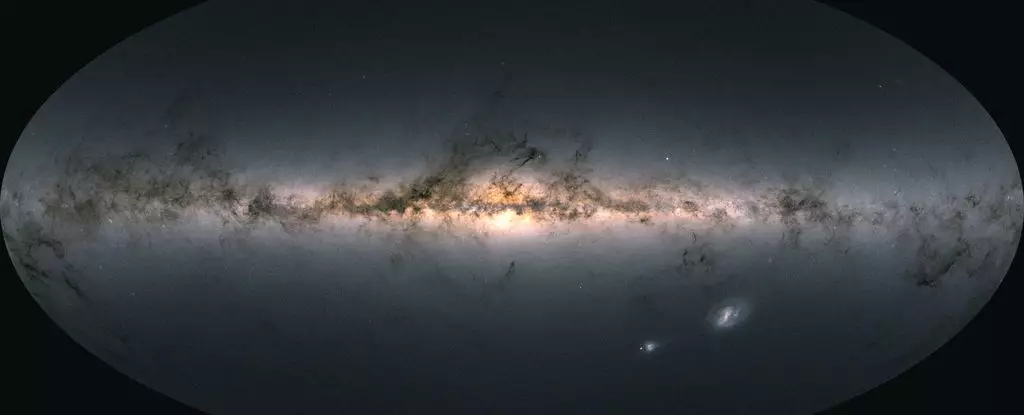The universe holds secrets that often elude our understanding, yet recent findings have begun to shed light on hidden wonders. Among the most riveting discoveries is the potential existence of a supermassive black hole lurking within the Large Magellanic Cloud (LMC), a satellite galaxy orbiting our Milky Way. While black holes are known to exist in various masses, this particular one could challenge existing notions about their formation and growth, providing unprecedented insight into the life cycle of these cosmic giants.
Led by astrophysicist Jiwon Jesse Han from the Harvard & Smithsonian Center for Astrophysics, a detailed study has emerged that suggests the presence of a substantial, invisible object residing within the LMC, estimated to have a mass of approximately 600,000 solar masses. This intriguing find indicates that the black hole exists in a mass range that is comparatively rare—less than a million times the mass of our Sun—which could significantly reshape our current understanding of black hole formation. The insights gleaned from this discovery—available in the preprint server arXiv and set for publication in The Astrophysical Journal—prompt scientists to reconsider the mechanisms behind how black holes evolve from smaller to colossal sizes.
Investigations into stellar dynamics often reveal black holes through their interactions with surrounding stars. In this case, Han and his team opted for a different approach, examining hypervelocity stars—unusually fast-moving stars that strut through the galaxy at velocities significantly greater than their peers. Unlike typical stars, these hypervelocity outliers can travel so rapidly that they risk escaping the gravitational pull of our galaxy altogether.
The Hills Mechanism: Acceleration Through Gravitational Interactions
The theoretical framework that underpins the discovery is based on the Hills Mechanism, a gravitational interaction involving three bodies: a black hole and two stars. Through this complex dance, one star is dramatically accelerated and flung into the cosmos, a phenomenon that provides valuable clues to researchers studying unseen black holes.
The Gaia space telescope, during its tenure in orbit, meticulously catalogued positions and velocities of Galactic objects in a three-dimensional context. This treasure trove of data allowed Han and his collaborators to focus on 21 hypervelocity stars in the Milky Way’s outer envelope, establishing connections to the Hills Mechanism. Their effort culminated in the tracing of 16 stars with origins that could feasibly align with the influence of a black hole. Notably, seven of these stars traced their lineage back to Sagittarius A*—the supermassive black hole at the Milky Way’s heart—while nine exhibited trajectories consistent with ejection from the LMC.
A Galactic Collision on the Horizon
Currently, the Large Magellanic Cloud is situated about 160,000 light-years away from our galaxy. The trajectory of this dwarf galaxy is not straightforward; instead, it is engaged in an intricate gravitational ballet with the Milky Way, with an anticipated collision projected to occur in roughly 2 billion years. This cosmic event will inevitably lead to a merger of the two galaxies and possibly result in the supermassive black hole from the LMC spiraling into our galaxy’s center, joining forces with Sagittarius A*.
Such an event promises more than just a spectacular cosmic show; it raises profound questions about the nature of black holes and their evolutionary processes. This merger could illustrate a tangible pathway through which black holes increase in size, transforming relatively modest black holes into entities equivalent to hundreds of millions or even billions of solar masses. The prospect of witnessing such evolutionary processes in real time, albeit over cosmic scales of time, is riveting and underscores the dynamic nature of our universe.
While the current discovery marks a significant step in unlocking the mysteries of black holes, it also opens the door to future inquiries that could further illuminate this enigmatic domain. Confirming the existence and properties of the hypothesized black hole within the LMC will not only enhance our understanding of black hole formation but also offer insights into galaxy interactions and evolutions across the cosmos.
The study led by Han is a shining example of how curiosity-driven research can unveil the hidden mysteries of the universe. As astronomers continue to grapple with the complexities of black holes, each discovery illuminates new pathways of inquiry that challenge our foundational understanding of the cosmos. It is through these remarkable revelations that we begin to unravel the dense tapestry of our universe, revealing a dynamic and interconnected cosmic narrative that continues to unfold over the ages.


Leave a Reply